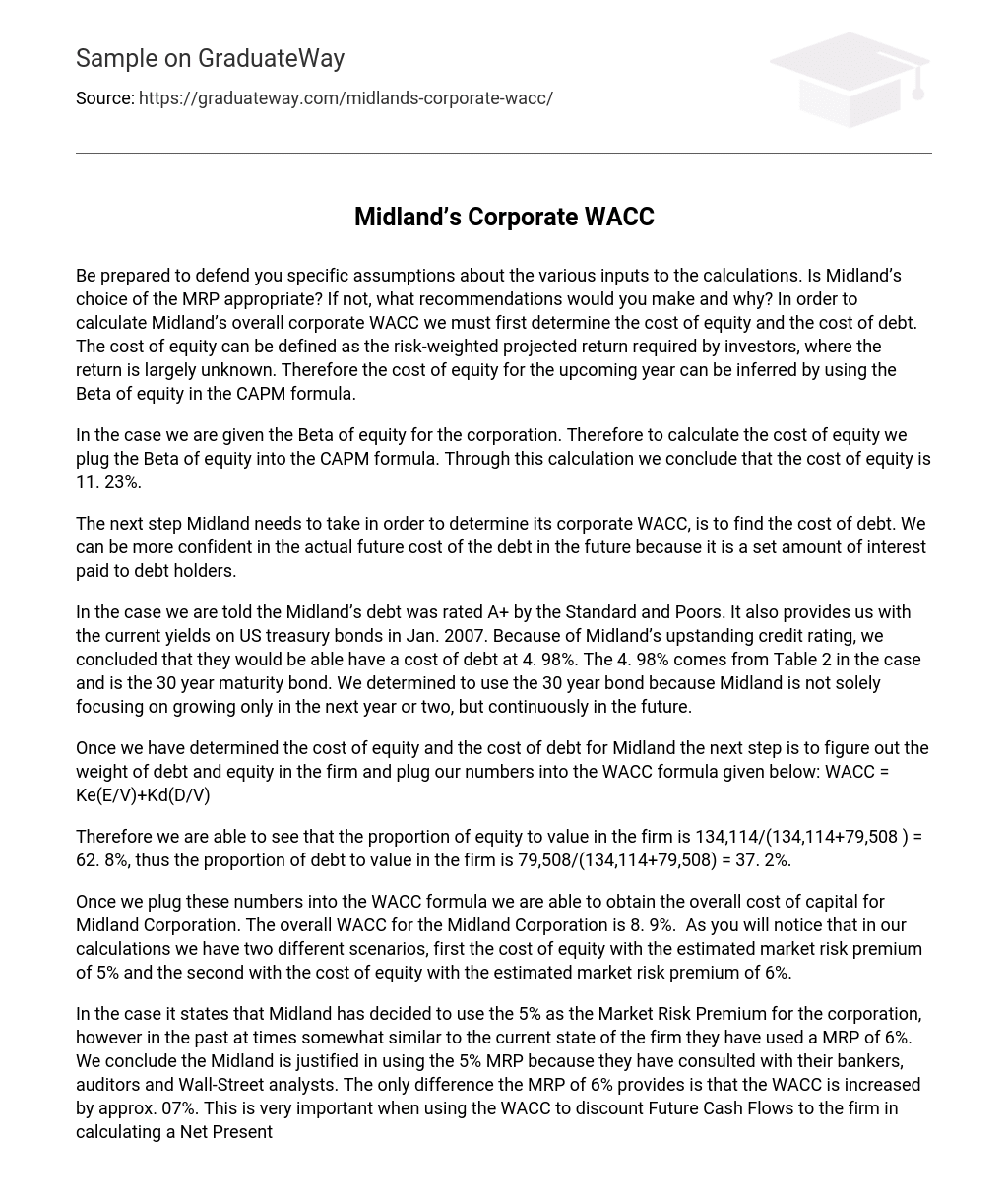Be prepared to defend you specific assumptions about the various inputs to the calculations. Is Midland’s choice of the MRP appropriate? If not, what recommendations would you make and why? In order to calculate Midland’s overall corporate WACC we must first determine the cost of equity and the cost of debt. The cost of equity can be defined as the risk-weighted projected return required by investors, where the return is largely unknown. Therefore the cost of equity for the upcoming year can be inferred by using the Beta of equity in the CAPM formula.
In the case we are given the Beta of equity for the corporation. Therefore to calculate the cost of equity we plug the Beta of equity into the CAPM formula. Through this calculation we conclude that the cost of equity is 11. 23%.
The next step Midland needs to take in order to determine its corporate WACC, is to find the cost of debt. We can be more confident in the actual future cost of the debt in the future because it is a set amount of interest paid to debt holders.
In the case we are told the Midland’s debt was rated A+ by the Standard and Poors. It also provides us with the current yields on US treasury bonds in Jan. 2007. Because of Midland’s upstanding credit rating, we concluded that they would be able have a cost of debt at 4. 98%. The 4. 98% comes from Table 2 in the case and is the 30 year maturity bond. We determined to use the 30 year bond because Midland is not solely focusing on growing only in the next year or two, but continuously in the future.
Once we have determined the cost of equity and the cost of debt for Midland the next step is to figure out the weight of debt and equity in the firm and plug our numbers into the WACC formula given below: WACC = Ke(E/V)+Kd(D/V)
Therefore we are able to see that the proportion of equity to value in the firm is 134,114/(134,114+79,508 ) = 62. 8%, thus the proportion of debt to value in the firm is 79,508/(134,114+79,508) = 37. 2%.
Once we plug these numbers into the WACC formula we are able to obtain the overall cost of capital for Midland Corporation. The overall WACC for the Midland Corporation is 8. 9%. As you will notice that in our calculations we have two different scenarios, first the cost of equity with the estimated market risk premium of 5% and the second with the cost of equity with the estimated market risk premium of 6%.
In the case it states that Midland has decided to use the 5% as the Market Risk Premium for the corporation, however in the past at times somewhat similar to the current state of the firm they have used a MRP of 6%. We conclude the Midland is justified in using the 5% MRP because they have consulted with their bankers, auditors and Wall-Street analysts. The only difference the MRP of 6% provides is that the WACC is increased by approx. 07%. This is very important when using the WACC to discount Future Cash Flows to the firm in calculating a Net Present Value and determining if they will accept or decline a project.
Our advice to Midland is that they can use the 5% to discount Cash Flows, but if their decision comes down to a very small positive NPV they should discount the Cash Flows at 6% and if that provides them with a negative NPV they should not accept the project. The most important thing for Midland to remember is that all of these projected costs of capital numbers are all inferred and they should be used with multiple scenarios to account for various economic conditions.





